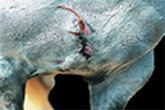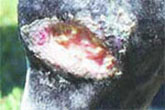Saddle Creek Farm
(760)-468-4970-Equine Retirement, Horse Retirement, Equine Boarding, Post-Op, Lay-Up
Veterinary Wound Management

Saddle Creek Farm Follows Veterinarian's Wound Care and Bandaging Instructions
Professional equine wound management and treatment is very important and necessary to ensure your horse fully recovers from wounds, injuries or surgery. To achieve these goals, Saddle Creek Farm management and staff works closely with the attending veterinarian regarding equine health care and follows the veterinarian's wound management and treatment process to help your horse heal quickly. No matter how the injuries occurred, they go through a healing process and if the injury or wound closure is hindered, scar tissue tends to build. To minimize scaring, early intervention and treatment helps speed up the healing process. Saddle Creek Farm maintains a qualified staff on the grounds at all times to administer around the clock injury and wound care to our equine residents.
 Some first aid guidelines
Some first aid guidelines
You should be prepared for the potential mishap with the proper first aid and equine wound dressing materials available, because wounds from underbrush or bumping against a fence are inevitable.
When your horse does need first aid, assess the wound or laceration and decide if it is something that requires veterinary wound management for proper care of horse wounds. If you can handle it yourself, you will need equine first aid materials to treat superficial wounds, abrasions, minor wounds, irritations and skin lesions. For hoof injuries have your veterinarian examine and recommend the equine hoof care needed to cure the problem.
Some first aid guidelines while waiting for your veterinarian
If the wound is very large or deep, if your horse is lame or if the wound is near any joint or tendon, it probably needs veterinarian wound care treatment and management.
- Avoid touching or clipping around the wound, to prevent contamination.
- Do not apply your medication to the wound because many antiseptics, detergents, ointments and powders interfere with healing.
- Direct pressure using a thick bandage can be applied to the wound to stop bleeding, but never apply a tourniquet which should only be applied by a veterinarian.
- Bathing with cotton or wool can introduce contamination.
- Strong antiseptics can kill cells as well as bacteria; instead, use very mild solutions such as a saline solution.
- Colored sprays and wound powders can act as foreign bodies and can be irritating to cells; instead, use creams and moist wound dressings as recommended by your veterinarian.





